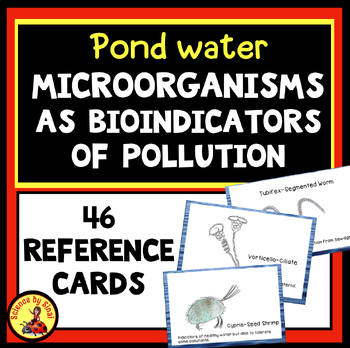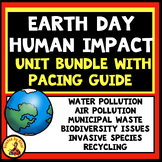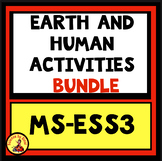Pond Water MICROORGANISMS BIOINDICATORS of Water Pollution 46 Reference
- PDF
Also included in
- Here is my 2-3 week unit bundle for teaching Human Impact and Earth Day as part of MS-ESS3-3, MS-LS2-3 and MS-LS2-4. Easy prep activities. There is a detailed pacing guide that also includes links to my blog posts that helps you build out each activity. Please see the detailed preview.Topics IncludePrice $51.80Original Price $64.75Save $12.95
- Here is a set of 46 bioindicator microorganism identification cards for students to use as they search for creatures using microscopes looking at pond water. Also included is a data collection form and a final project rubric. Please see the descriptions and previews of each of the two products.Price $6.90Original Price $8.25Save $1.35
- After teaching science for over 30 years, I finally put together my middle school and upper elementary ecology and environmental science, ecosystems, food chains and webs, biodiversity, Earth Day, STEM and CER resources! Click on the preview for complete details!The resources range from interactivePrice $252.60Original Price $315.75Save $63.15
- 11 interactive activities dealing with the impact of humans on the environment that are super for Earth Day and MS-ESS3-3. Included in this bundle:STEM Design a Water FilterMicroorganisms as Bioindicators of Water Pollution Reference CardsSTEM Air Pollution Graphing ActivityExcess Product PackaginPrice $35.60Original Price $44.50Save $8.90
- Here are 8 products for your human impact, water pollution unit. Students read about filtration and answer questions, create a water filter, check the excess packaging of products, go on a types of plastic scavenger hunt, and analyze the quality of a local body of water using microorganisms as bioinPrice $25.00Original Price $31.25Save $6.25
Description
Students observe and identify pond water microorganisms with microscopes to determine if it is polluted or not. Here are 46 reference cards of protists and invertebrates with pollutant tolerance levels indicated. Some common protists and pond organisms can be used as bioindicators.
Are you studying MS-ESS3-3 or HS-ESS3-4 and discussing the impact that humans have on our waterways?
For years I have taken my middle school classes to a nearby pond to collect organisms to look at under the microscope. I absolutely love the excitement of the students as they find new creatures each day!
While studying water pollution in the MS-ESS3-3 standard we talk about the runoff from the streets into the local waterways and the effects that it can have on the organisms in a pond or streams nearby. Nothing makes them understand this more than seeing the creatures and evaluating the pollution level themselves!
The problem I ran into throughout the years was the students really didn’t want to plow through pages and pages of reference books to try to figure out what the creatures were and they just wanted me to quickly identify them. I found myself making representative sketches on the board every year and then I decided to make these reference cards to laminate and keep out on a desk for them to use.
Students seem to like this new “game“ of seeing how many of the creatures that they can actually find. I find that the cards help bring them back to the original task of deciding whether or not the lake is polluted or not rather than just being excited about finding creatures.
I do this in my six grade environmental science unit and my seventh and eighth graders beg to come back in each year. This year I had a day with seventh graders in the same room teaching the six graders how to take videos through the microscopes with their iPads and helping them to identify the creatures.
Included are 46 of my drawings of the most common single celled and multi celled organisms found in slow-moving ponds. I have done the research for you as to what type of environment each organism can or can not tolerate such as low oxygen, nitrogen or phosphate levels, metal or heat pollution.
I have included two images per 8 1/2 x 11 page, to save on ink, and have found it is best to print these cards out and laminate them to either post them on a bulletin board or spread them out on a table as the students work. I have the students keep a running journal throughout my 1 to 2 week exploration and by the end of the activity they should have an understanding of the overall quality of the water based on which organisms were discovered.
Included in this resource:
- Teacher Notes
- NGSS Standard
- Teacher Directions
- 46 of My Drawings of Microorganisms plus their pollution tolerance level
==>My blog post at Sciencebysinai.com called Identifying Pond Water Microorganisms as Bioindicators describes how I do this super fun unit!
Are you looking for other science resources? NGSS aligned activities? Science classroom decor or clip art? Please check out the rest of my store at SCIENCE BY SINAI.
https://www.teacherspayteachers.com/Store/Science-By-Sinai
Follow Me
Do you want to be the first to find out when I post a new resource? Please click on the green star next to my name to FOLLOW MY STORE, SCIENCE BY SINAI, and to get an email each time I post a new product. As a follower you will also get notifications of freebies and sales!
Check me out on social media.
https://www.pinterest.com/karensinai2/
https://www.instagram.com/sciencebysinai/
https://www.facebook.com/Science-by-Sinai
Feedback
**Did you know that you can save money on TpT resources by leaving feedback? Go to your “My Purchases“ page and leave feedback on the resources you’ve purchased to earn TpT credits!
Copyright.
Each purchase is a license for ONE person to use in a classroom setting. It is a violation for individuals, schools and districts to redistribute, edit, sell, or post this item on the Internet or to other individuals. Disregarding the copyright is a violation of the Digital Millennium Copyright Act and subject to legal action. By purchasing this product you acknowledge that you have read and understood these terms of use.










